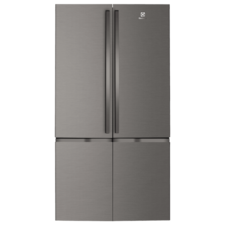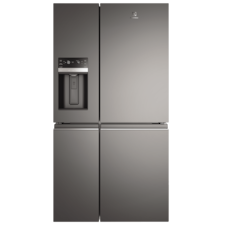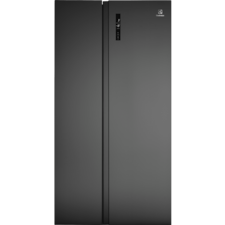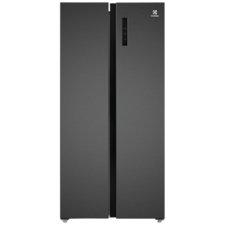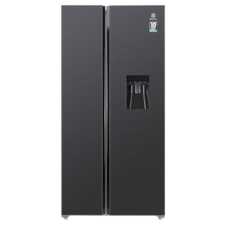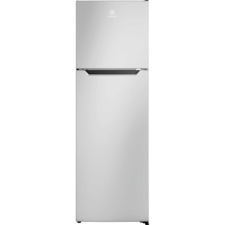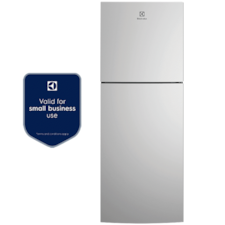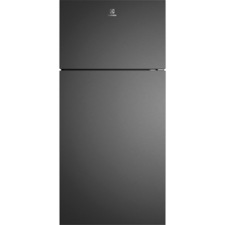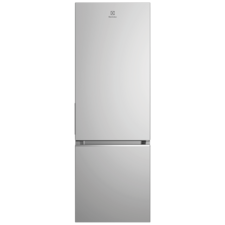It may have been a while since you’ve shopped for a new refrigerator. While their purpose remains the same, there are new technologies to keep your ingredients fresher for longer.
With more style and configuration options on offer than ever before, we’re here to help simplify your decision-making process with these helpful fridge buying tips. Read on to discover valuable tips on how to choose a good refrigerator for your needs.
1. Refrigerator capacity and volume
What is refrigerator capacity?
The capacity of a refrigerator refers to the total volume of storage space available inside the unit, typically measured in liters or cubic feet.
When exploring fridge specifications, you'll encounter two primary terms: gross capacity and net capacity.
- Gross capacity: Represents the total volume of the refrigerator, essentially the outer dimensions of the refrigerator, such as the length, width and height.
- Net capacity: Indicates the usable storage space within the refrigerator. It's the volume that's actually available for storing your food and beverages. This is the figure you should primarily focus on when comparing different models.
How to choose a fridge capacity by family size
Here’s a simple guide table to help you visualise the relationship between household size and refrigerator net capacity:
|
Family size |
Refrigerator net capacity/volume (litres) |
|
1 - 2 people |
150 - 250 litres (small-sized fridges) |
|
3 - 4 people |
250 - 450 litres (medium-sized fridges) |
|
5+ people |
450+ litres (large-sized fridges) |
2. Refrigerator sizes and dimensions
When choosing a refrigerator, it's crucial to consider not only the capacity but also its physical dimensions. Typically, the width, height, depth, and capacity of refrigerators vary based on their type and design. Here's a quick overview of average fridge size chart in litre and centimeter based on their type:
|
Type of refrigerator |
Size (litre) |
Dimensions (cm) |
|
150-500L |
W: 54-80, H: 140-180, D: 55-70. |
|
|
250-450L |
W: 54-80, H: 140-180, D: 55-70. |
|
|
350-600L |
W: 80-90, H: 170-180, D: 70-75. |
|
|
400-650L |
W: 80-90, H: 170-180, D: 70-75. |
|
|
40-100L |
W: 45-55, H: 50-85, D: 50-85. |
|
|
Single door refrigerator |
100-250L |
W: 50-60, H: 115-150, D: 55-65. |
Remember, while these are standard refrigerator sizes, it's always a good idea to check specific model dimensions either online or in-store before making a purchase.
3. How to measure your kitchen for a new refrigerator?
Now that you have a general understanding of standard fridge sizes, let's learn how to measure your space step-by-step to determine the right fridge size for your needs.
Step 1: Measure your space
- Width: Measure the width of the space where you plan to place the refrigerator. Do this at several points to account for any irregularities like uneven walls or protruding baseboards.
- Height: Measure from the floor to any overhead obstruction like cabinets. Measure in multiple locations to compensate for uneven floors.
- Depth: Consider the depth of the space, keeping in mind that the refrigerator doors need to swing open. There should be sufficient space in front of the refrigerator to allow easy access and airflow.
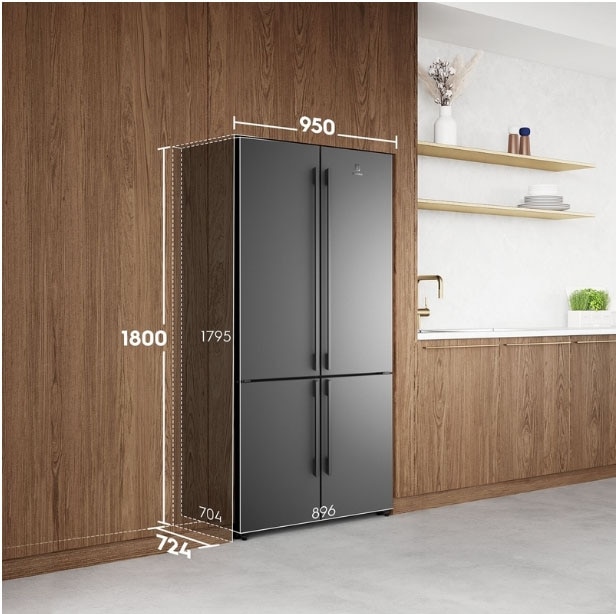
Step 2: Plan the delivery path
Note any tight entryways, corners, and narrow hallways that the refrigerator must pass through upon delivery. Use the width and depth measurements to ensure your new refrigerator can be moved into your kitchen without issue.
Step 3: Kitchen layout or work zone considerations
When it comes to designing the space for your refrigerator in the kitchen, you need to think about how you’d like to move around the room. It will be important to make sure your kitchen and appliances work with you. Things you need to consider are:
- Ensure that the space where you plan to install the refrigerator does not obstruct kitchen traffic or interfere with the use of other appliances.
- Consider the swing direction of the refrigerator doors and whether they can open fully without hitting islands, counters, or other obstacles.
- Work zones have it broken up into five zones: consumables, non-consumables, cleaning, preparation and cooking zones, which is the best layout for working with someone else. If your space is smaller, you should consider a kitchen triangle or work zone in which your refrigerator, cooking appliances, and sink/dishwasher create a triangle as if a line is drawn to link them together.
Important notes:
- Always check for any additional space requirements specified by the manufacturer for installation.
- Leave at least 2cm of space on the sides and back of the refrigerator for proper ventilation.
- Consider future changes in your kitchen layout or potential moves that might require different refrigerator dimensions.
4. Types of refrigerators
In the previous section, we mentioned the common capacity and size ranges of refrigerators. However, it is also important to consider the different types of fridges and determine which type best suits your needs. Here is a guide to help you understand the various available options.
French door refrigerators
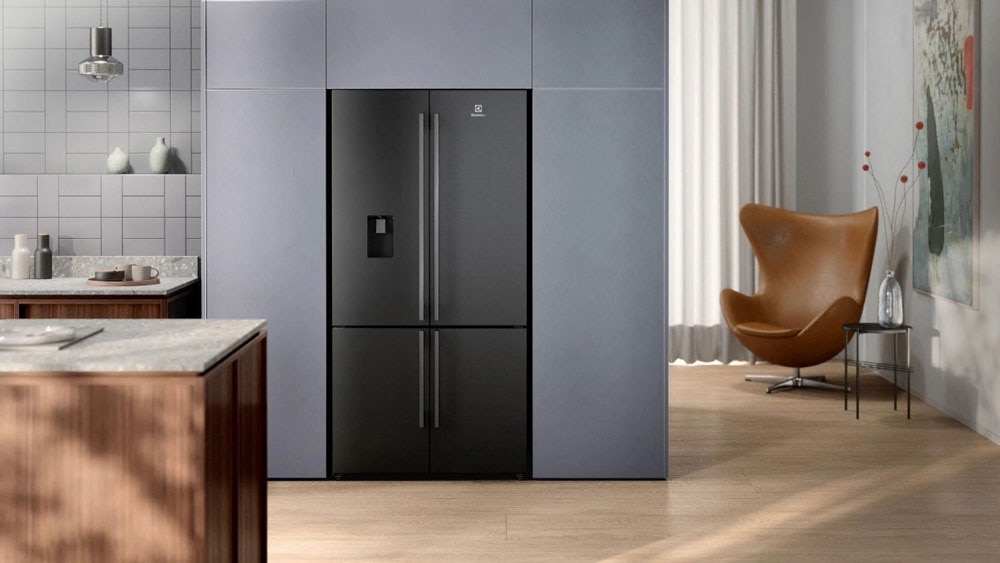
Typically measuring between 350 and 600L, French door refrigerators come with plenty of storage and style options such as adjustable storage, as well as ice & water dispensers.
You can configure these into three sections - two refrigeration sections and one large freezer or two refrigeration sections and two freezer sections. Some models include a middle drawer which can be converted from refrigerator to freezer. Learn 5 advantages of a French door refrigerator.
Below are Electrolux’s recommendations for buying a French door refrigerator:
- Storage space for all types of food and drinks.
- TasteLockPlus keeps vegetables fresh for 7 days*.
- EvenTemp reduces temperature fluctuations.
Discontinued
- TasteSealFlex ideal storage with 5 temperatures.
- TasteLockAuto keeps vegetables fresh for 7 days*.
- TwinTech cooling help preserves taste and texture.
- Compact French-door fridge with spacious storage.
- Optimise storage with TasteLock dual crisper.
- EvenTemp reduces temperature fluctuations.
Side by side refrigerators
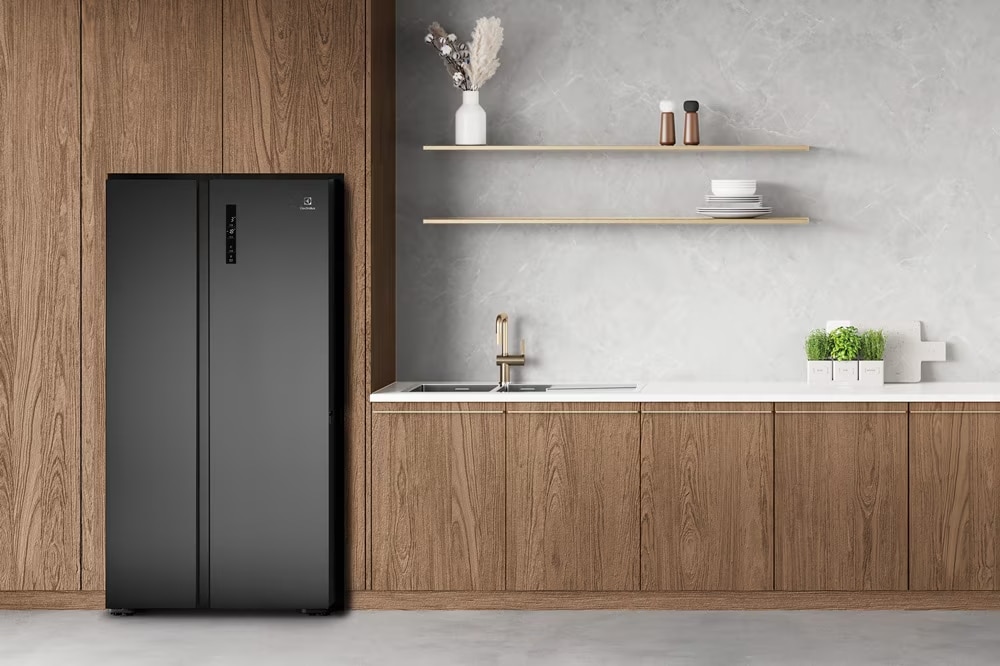
Side-by-side refrigerators typically range from 400 to 650 liters and feature two doors opening from the center, providing easy access to both the refrigerator and freezer compartments.
Below are our side-by-side refrigerator recommendations:
- NutriFresh inverter compressor saves energy.
- TasteLock keeps vegetables fresh and tasty.
- EvenTemp reduces temperature fluctuations.
- NutriFresh inverter compressor saves energy.
- TasteLock keeps vegetables fresh and tasty.
- EvenTemp reduces temperature fluctuations.
- NutriFresh inverter compressor saves energy.
- TasteLock keeps vegetables fresh and tasty.
- WaterStream for chilled water through the door.
Discontinued
Top freezer refrigerators
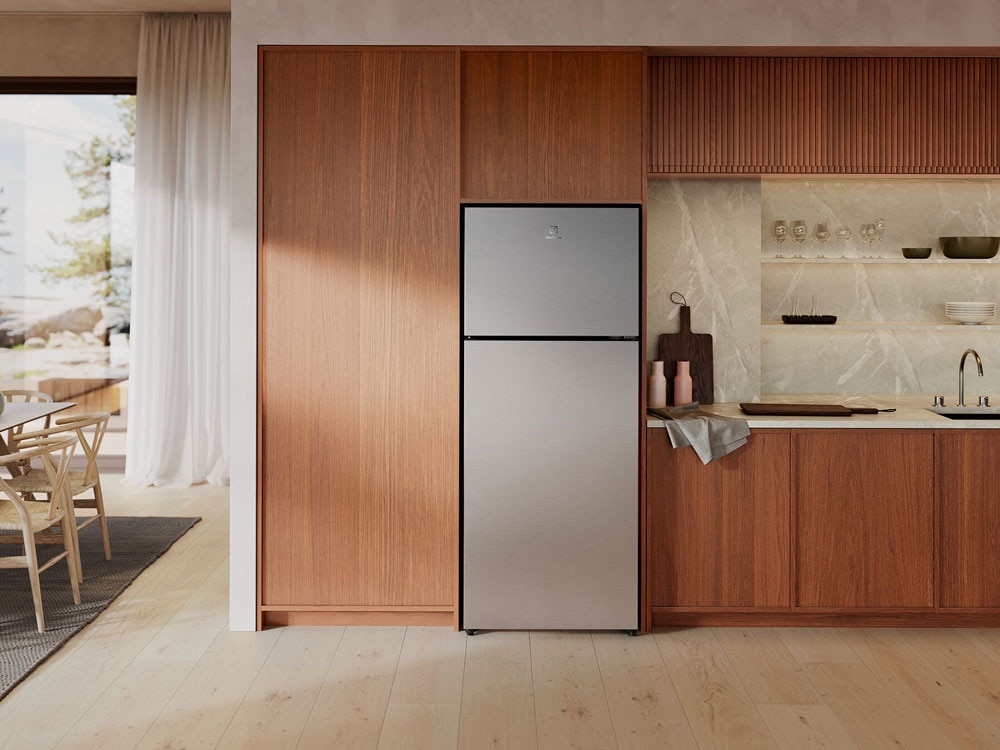
A two-door refrigerator with top mount freezer is a more traditional layout of single door refrigerator with the freezer placed at the top for eye level access for your frozen ingredients or treats. With a capacity ranging from 150 – 500L, this style of refrigerator would be suitable for a small family or apartment living where you access your freezer quite regularly.
Check out our top freezer refrigerators:
- DynamicAir stabilises temperatures to stop foods from drying out.
- Inverter Technology significantly saves energy.**
- Store cheese and cold cuts in ExtraChill drawer.
- TasteSeal keeps fish for 7 days* without freezing.
- TasteLock keeps vegetables fresh and tasty.
- EvenTemp reduces temperature fluctuations.
- AI AutoSense saves up to 10% energy*.
- Retains up to 90% Vitamin C after 7 days*.
- ExtraChill drawer ideal for deli meats and cheese.
*Disclaimer: Pictures are for illustration purpose only and not necessarily the products that are sold.
Bottom freezer refrigerators
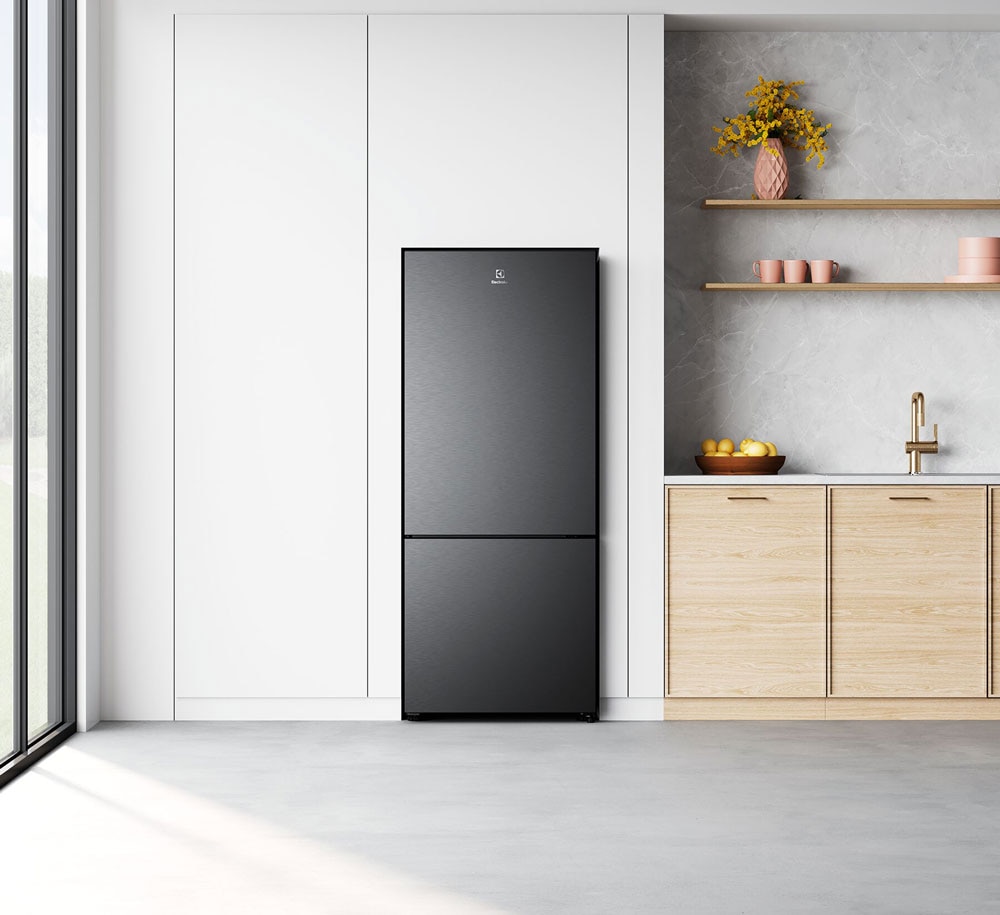
Bottom mount freezer refrigerators are ideal for small families or apartments with limited space. These models, typically ranging from 250 to 450 liters, offer many features found in larger refrigerators while prioritising easy access to the main food compartment.
- TasteSeal keeps fish for 7 days* without freezing.
- TasteLockAuto keeps vegetables fresh for 7 days*.
- EvenTemp reduces temperature fluctuations.
Mini fridges (or mini bar fridges)
If you need more space for drinks or need a small refrigeration and freezer option for short stay accommodation, a one-door mini bar refrigerator is worth your consideration. With shelving and a full-width ice box, you are able to store your items the way you want to. The capacity of a mini bar fridge usually falls between 40 and 100L.
- Compact mini bar is quiet and efficient.
- CoolZone for extra cold goods.
- Extra deep door bin for storing big bottles.
5. Tips for choosing an energy-efficient refrigerator
Refrigerators are graded with Energy Star ratings, where a higher star rating indicates better energy efficiency. Models with 5-star ratings are the most energy-efficient, consuming less power and offering more cost savings over time. These refrigerators might have a higher upfront cost but typically pay off in the long run through reduced utility bills.
Modern refrigerators often come equipped with features that enhance their energy efficiency. These include inverter compressors that adjust cooling speeds based on demand, vacuum insulation panels, and other technologies that minimize energy loss.
An easy tip for choosing an energy-efficient refrigerator is to always check the energy label and compare the annual energy consumption in kilowatt-hours (kWh) to gauge how much the appliance will cost to run annually.
You might want to consider our Electrolux NutriFresh™ Inverter refrigerators as they are widely known for being highly energy efficient. Read our article on How many watts an Electrolux refrigerator consumes per day to how much you can save on your electricity bill.
6. Pick your top 3 favourite brands
When choosing a refrigerator, consider well-established brands renowned for their high-quality products and commitment to sustainability, such as Electrolux Indonesia. Research thoroughly by visiting their websites and physical stores to gain a deeper understanding of their offerings. Narrow down your choices to your top three favorites and carefully compare them based on your specific needs and budget.
Crucially, don't overlook the importance of easily accessible customer service centre or hotline. Ensure the brand provides readily available support, including a reliable hotline, for peace of mind in case of repairs or warranty claims.
The ideal refrigerator choice ultimately depends on your individual grocery habits, budget, and specific needs. By selecting an Electrolux refrigerator, you can confidently invest in a reliable and durable appliance that will serve your family for years to come.
7. Refrigerator features to look for
When buying a new refrigerator, it's crucial to consider the latest technologies designed to enhance food preservation, improve usability, and make your kitchen more efficient. Here are key features to consider when selecting your next refrigerator:
Advanced temperature control
Refrigerators equipped with advanced temperature control systems provide a stable environment that helps extend the shelf life of your food, ensuring everything from meats to vegetables remains fresh for longer. Features such as independent cooling systems and humidity controls work together to maintain optimal conditions within the fridge.
In 2018, the Electrolux NutriFresh Inverter refrigerator received a prestigious award from the Indonesian World Record Museum (MURI) for its exceptional ability to maintain the freshness of fruits and vegetables for an extended period. Here's how Electrolux models make this possible:
- TasteSeal: This compartment provides precise temperature control, keeping meat and fish fresh for up to 7 days.
- TasteLockAuto: Automatically adjusts humidity levels to keep fruits and vegetables fresh for longer.
- TwinTech Cooling: This innovative technology uses two separate cooling systems to maintain optimal temperature and humidity levels in both the refrigerator and freezer compartments.
- EvenTemp: Ensures consistent temperature throughout the refrigerator, preventing temperature fluctuations that can spoil food.
>>> Read more:
- What is the right refrigerator temperature for storing food?
- How to store vegetables and fruits in the refrigerator
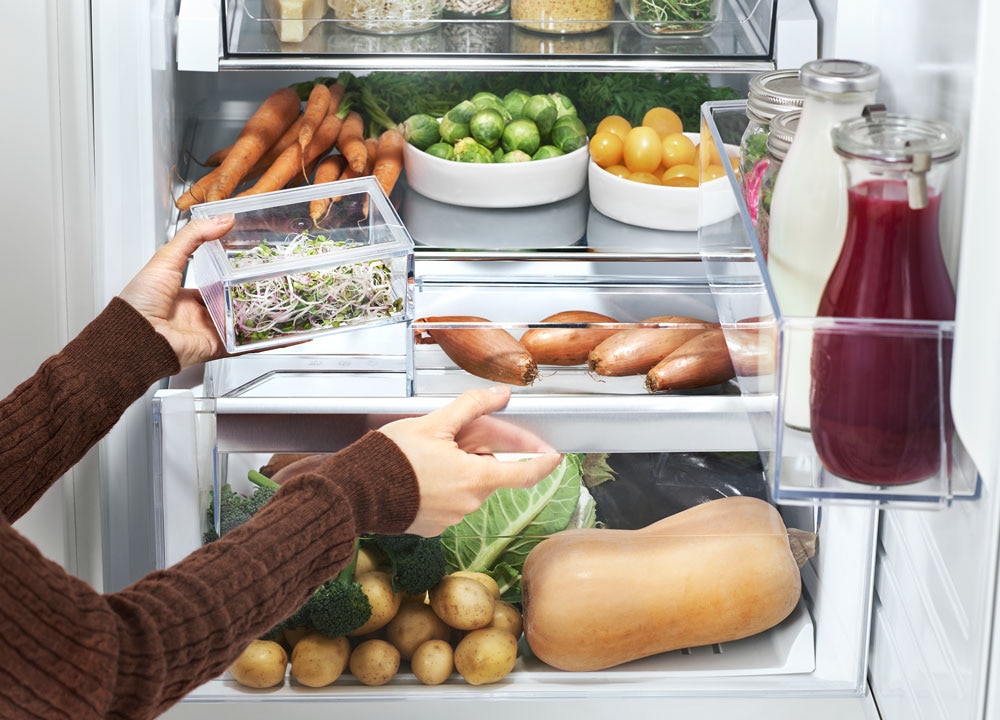
Hygiene and odor control
Maintaining a clean and odor-free refrigerator is essential for food safety and can enhance the flavor of your stored items. Electrolux refrigerators feature advanced hygiene and odor control technologies like TasteGuard to eliminate smells and maintain a hygienic storage environment.
>>> Check out more manual cleaning tips from Electrolux Indonesia:
Convenience and design
Modern fridges, such as the Electrolux UltimateTaste 700 French door refrigerator, are not just about keeping food cold; they are also designed to fit seamlessly into your lifestyle and kitchen aesthetics while meeting your storage needs.
Electrolux refrigerators come with a variety of features that enhance convenience and elevate the design of your kitchen.
- WaterStream and AutoIce: Enjoy the convenience of filtered water and ice, right at your fingertips.
- QuickChill: Quickly lowers the temperature of food and drinks to a low temperature of 2°C for up to 90 minutes.
- FlexStor: Customize your refrigerator's interior to accommodate items of various sizes.
- Sleek design: Choose from a range of stylish designs, including sleek stainless steel and fingerprint-resistant finishes.
8. Consult reviews and ratings
When choosing a refrigerator, consulting reviews and ratings from other consumers can provide invaluable insights into the appliance's performance, reliability, and the manufacturer's claims. These real-life opinions help paint a clearer picture of how the refrigerator functions in daily life and highlight any potential strengths or issues.
Make the most of our Store locator tool to find the nearest stores in your area where you can purchase Electrolux refrigerators. By visiting these stores, you will have the opportunity to view our latest refrigerator models and other high-quality home appliances in person, receive expert and personalised advice, make an informed purchase, and much more.
Refrigerator buying tips: FAQs
-
1. How to use a new refrigerator?
Here are some important tips after buying a new refrigerator:
- Clean the interior thoroughly with a mild detergent solution.
- Allow it to dry completely before adding food.
- Refer to your user manual for specific instructions on temperature settings, defrosting (if applicable), and any special features your model may have.
-
2. How to install a new refrigerator?
Refer to your user manual for detailed installation instructions. Ensure the refrigerator is level and properly ventilated. Before plugging in your new refrigerator, allow it to stand upright for at least 4 hours (or as recommended in your user manual). This allows the refrigerant to settle properly, preventing potential damage to the compressor.
If you are unsure about any aspect of the installation, consult a qualified technician for assistance.
-
3. How to clean a new refrigerator?
Wash the interior shelves, drawers, and door liners with a mild detergent solution and warm water. Rinse thoroughly and dry completely with a soft cloth. Avoid using abrasive cleaners or harsh chemicals. Make sure to refer to your user manual for specific cleaning recommendations for your model.
-
4. What things should be considered when buying a refrigerator?
Choosing the right refrigerator involves careful consideration of several factors:
- Capacity and volume
- Size and dimensions
- Your installation space or kitchen layout
- Refrigerator types
- Energy efficiency
- Temperature, odor, and hygiene control feature
- Brand reputation and reliability
- Consumer reviews and ratings
-
5. How long can a new refrigerator be used?
Most refrigerators last 10-15 years, depending on the brand, usage, and maintenance. Investing in a reliable brand and proper care can extend its lifespan.
-
6. What temperature should a refrigerator be?
According to U.S. Food and Drug Administration, refrigerator temperature is recommended to be at or below 4° Celsius. However, not all refrigerators are equipped with a thermometer, making determining the right temperature confusing. Fortunately, the price of refrigerator thermometer is considerably cheap and can be bought at most kitchen appliance stores.

